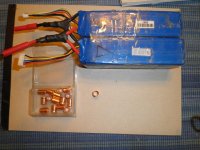It may be important, depending on the way the conductors themselves are connected together. If they are already tightly connected without the solder, then they should have low enough resistance to not be a problem even without solder, as long as water cannot get in there to cause corrosion between strands. If they were loose (or not tight) fitting strand to strand, then there may be gaps between them that don't conduct anything, raising the resistance of the joint and decreasing it's effectiveness.
How specifically are they meshed together? Do you have any pictures of the process? (better than descriptions) Knowing this may help us figure out a non-destructive way you can tell.
Normally, to accurately determine penetration, one must cut the joint in half (lengthwise, along the wire) and examine it. This would usually be done in practice sessions with scrap wire of the same type, and similar lengths to be used (to duplicate heat conduction away from the joint being made), and vary the process of soldering until the results are what you want. Then use that process on the final joint and be "sure" it works as desired.

This isn't practical for most people, so often the best recommendation is to make sure you have a fat chisel-tip high-wattage iron. The fat tip (perhaps half the of an average pinky finger or better) holds enough heat to begin to feed the joint while the high wattage (60-80w) feeds the tip to keep it hot enough to finish.
Another option is to crimp the joint using copper (or tinned copper, or even steel) ferrules, and a quality crimper, either ratcheting or hydraulic. This may cost more than the soldering iron for the crimper and ferrule "kit" of different gauges, but can make more reliable connections (essentially coldwelding the conductors all together), and a crimped joint is more flexible (past the joint) than a soldered one (which has flowed solder up into the wire past the joint, and can be brittle there and may break under flexing / vibration).
cmmx said:
I've meshed two 10 gauge braided wires together for an RC speed control. The joint feels strong, but I cannot determine if the solder penetrated to the center wires. First, is this important? Second, if it is, what would be the best approach for ensuring it has? I should have applied flux first, but forgot. I'm also unsure about re-wiring because it's 3 inches from the speed control and I don't want too much heat getting back to it.



